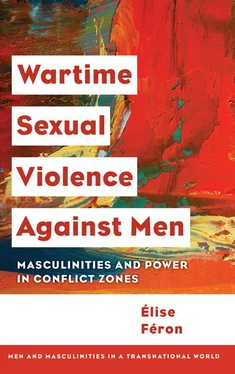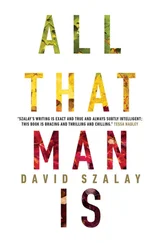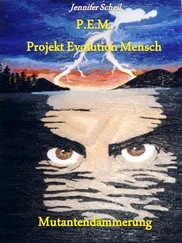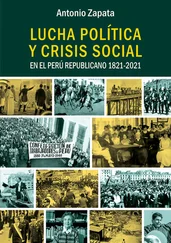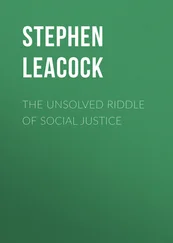Élise Féron
WARTIME SEXUAL VIOLENCE AGAINST MEN
MASCULINITIES AND POWER IN CONFLICT ZONES
I am forever indebted to those in Eastern DRC, Burundi, Rwanda, and Northern Ireland who agreed to share their stories with me, however painful and daunting. I am also grateful to all my colleagues and MA students in the Great Lakes region of Africa who encouraged me to write this book and who helped me to identify and meet relevant interlocutors for this research. All mistakes or misinterpretations remain my own, and I apologize if I have misrepresented or misinterpreted anything that I witnessed or was told.
A heartfelt thank you goes to Dr. Emanuela Mangiarotti for having read and commented on an earlier version of the manuscript and for the numerous stimulating discussions we have had, many of which are reflected in this book.
My sincere thanks also go to my colleagues at the Tampere Peace Research Institute in Finland, who have been highly supportive of this research.
Writing this book would have been impossible without my friends’ encouragement, and in particular without Marie-Cécile’s constant support.
May the road rise to meet you.
Scholarship has long established the multiple intersections between gender and conflicts, and recognizes gender as a fundamental dimension of politico-cultural mobilization in nationalist politics, conflict and war (Byrne 1996; Cockburn 2004b; Giles and Hyndman 2004; Mayer 2000; Nagel 1998). Literature has, for instance, explored how gender and ethnicity are used in narratives and political discourses, how gender roles, militarism and war are tightly interrelated, how conflict is likely to have a different impact on women and on men, and how the meanings of conflict and security might diverge for women and men. One particularly interesting and fruitful line of inquiry explores how masculinities and femininities are constructed in times of conflict and war, and how conflict actors aspire to build a masculine Self by disempowering/feminizing a threatening Other such that a new, strong masculinity is affirmed (Weeks 1985, 190). So, as the gender hierarchy becomes a signifier of a domination/subordination paradigm, male and female spheres of action and their mutual relations inform conflicts between political, social or cultural communities. Such analysis is particularly relevant for understanding how conflict-related sexual violence participates in enforcing relations of power, weaving together gender with other institutionalized dimensions of social power, for instance, nationalism, religious identity, caste, ethnicity, sexuality and politics.
Yet, despite a widespread recognition of the relational and intersectional character of gender, much of the existing literature has shown a tendency to treat gender as a women’s issue, especially when it comes to wartime sexual violence. It is, however, increasingly difficult to ignore the fact that wartime sexual violence targets men too, a fact that a few researchers and NGOs have been describing and analyzing since the mid-1990s, if not in a systematic fashion. As explained by Don Sabo, “Whereas researchers and public health advocates began to recognize the sexual victimization of women in Western countries during the late 1960s, it was not until the latter 1990s that the sexual abuse of men began to receive systematic scrutiny from human service professionals and gender researchers” (2005, 338). In the wake of research on sexual torture of male prisoners during civil wars in Chile, El Salvador or Greece, reports initially focused on the suffering of women have begun to unveil how widespread sexual violence against boys and men in military settings and conflict zones is, for instance, in regions like Eastern Democratic Republic of Congo (DRC) (Johnson et al. 2010), and that it has been a constant feature of most conflicts and wars, though most of the time silenced by political and military authorities, if not by victims themselves (Nizich 1994; Schwartz 1994; Carlson 1997; Oosterhoff et al. 2004; Carpenter 2006; Sivakumaran 2007). These publications have begun to shed light on the extent, features and consequences of this phenomenon, exploring the destructive power of such violence on individuals, but also on communities as a whole. It has, for instance, been shown that wartime sexual violence against men and boys is, like that committed against girls and women, mostly perpetrated by men in arms, belonging either to armed groups or to conventional armies. The combination of rape and sexual mutilation has also been described as the most prevalent form of sexual violence against men, especially in detention, alongside other forms of torture (Carpenter 2006, 94). Further, the public character of this violence, often inflicted in front of an audience, has been pointed at, even if that publicity never guarantees any kind of open debate afterwards, such as shown by Oosterhoff et al. in the case of Croatia (2004, 68).
To this date, however, monographs or articles addressing wartime sexual violence in general rarely dedicate more than a paragraph or a section to wartime sexual violence against men, and never mainstream it in the analysis (see, for instance, Eriksson Baaz and Stern 2013; Heineman 2011; Leatherman 2011; Meger 2016). As a review of policy-oriented as well as academic publications quickly reveals, research on sexual violence during conflicts focuses mainly on girls and women, to the extent that “rape as a weapon of war” [1] The expression has been become popular since the UN Security Council Resolution 1820 (2008) on Women and Peace and Security noted that “women and girls are particularly targeted by the use of sexual violence, including as a tactic of war to humiliate, dominate, instill fear in, disperse and/or forcibly relocate civilian members of a community or ethnic group”.
has almost become synonymous with sexual violence against girls and women during conflicts. Without a doubt, women make up the majority of victims of such types of violence. However, as we will see, there is good empirical evidence that in some settings like in Eastern DRC, around a third of all conflict-related sexual violence victims are male. Such percentages are hardly anecdotal, so why such an obliviousness? Even the media, with few exceptions, tend to treat wartime sexual violence and rape of women as synonymous, and ignore or gloss over male survivors, as Zarkov (2001) and Houge (2008) have shown in the case of the conflicts in former Yugoslavia. Many factors account for this silence, in particular the fact that systematic or detailed empirical evidence on wartime sexual violence against men is still hard to come by, mostly because more stress is usually put on other types of violence affecting civilian and combatant men, such as killing, maiming or imprisonment. And even if war historians have long been well aware of the practice, low levels of reporting on the ground mean that there is still no way to know exactly if this phenomenon is declining, stable or on the rise.
WHY WE NEED TO PAY ATTENTION TO WARTIME SEXUAL VIOLENCE AGAINST MEN
In the scholarship of gender and conflicts, the failure to systematically address and analyse wartime sexual violence against men eschews the relation between gender norms, sexual violence and the wider social order, and has important theoretical and practical implications. The tendency to associate victims of sexual violence exclusively with women essentializes women as victims and as vulnerable persons in need of protection. In parallel, it participates in the maintenance of stereotypes about men’s invulnerability and strength, and reinforces the essentialist equation that is often made between men, masculinity and violence, at the expense of other models of masculinity. In other words, far from helping to improve women’s situation, the silencing of male sexual victimization is highly detrimental to feminists’ objectives, because it reinforces the link between men, masculinity, power and invulnerability that is at the very core of patriarchal discourses: “Perceiving men only and always as offender and never as victims of rape and other forms of sexual violence is a very specific, gendered narrative of war. In that narrative, dominant notions of masculinity merge with norms of heterosexuality and definitions of ethnicity and ultimately designate who can or cannot be named a victim of sexual violence” (Zarkov 2001, 69).
Читать дальше
